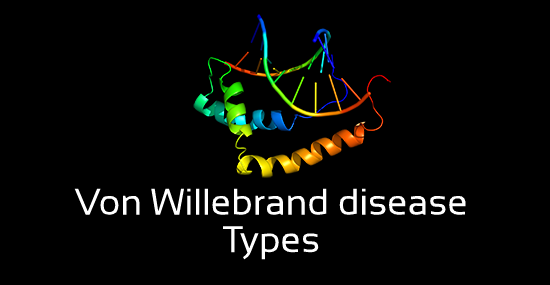VWD Types
What are the different types of von willebrand disease?
Von willebrand disease (VWD) is classified into three main types based on the plasma concentration of von Willebrand factor (if there is insufficient VWF) or the ability of VWF to function properly (if it does not function properly). The three main types are:
- Type 1
- Type 2
- Type 3
Laboratory tests and diagnostic procedures are critical components in the proper diagnosis and classification of von willebrand disease to determine if there is insufficient VWF or if it does not function properly. The von Willebrand factor (VWF) is a blood protein that affects the ability of the blood to clot properly.
Type 1
What is type 1 VWD?
Type 1 VWD is the mildest and most common type of VWD, it is characterized by mild symptoms and slightly decreased levels of VWF.
About 75% – 85% of patients with VWD have type 1.
Type 2
What is type 2 VWD?
Type 2 VWD is a common form of von Willebrand disease in which VWF does not function properly even if levels are enough and sufficient.
About 10 to 25% of patients with VWD have type 2.
What are the different subtypes of type 2 VWD?
Type 2 VWD is classified into four sub-types:
Type 2A is a form of Type 2 VWD characterized by insufficient levels of normal forms of VWF.
Type 2B is a form of Type 2 VWD characterized by malfunctioning Von Willebrand factor, in which the ability of the highly concentrated or sticky vWF to bind to GPIb (glycoprotein Ib) receptor on the platelet membrane is accelerated, leading to its spontaneous binding to platelets, which, in turn, can lead to unwanted platelet aggregation and aggravation of thrombocytopenia (low number of platelets in the blood). In this form the ristocetin cofactor activity is low and the presence of Large vWF multimers in the circulation is either diminished or absent.
Type 2M is a form of Type 2 VWD characterized by defective Von Willebrand factor, in which the ability of the poorly concentrated VWF to bind to glycoprotein Ib receptor on the platelet membrane is decreased or diminished, and as a result this protein loses most of its binding capability i.e. does not bind tightly enough to platelets. The defective and poorly concentrated VWF retains a normal capability at multimerization. In this form the ristocetin cofactor activity is decreased and large vWF multimers are present in the circulation.
Type 2N is a form of Type 2 VWD characterized by a mutation in VWF, in which the ability of the mutated VWF to bind to factor VIII is decreased. that does not bond well to factor VIII. In this form the ristocetin cofactor assay is normal.
Type 3
What is type 3 VWD?
Type 3 VWD is the rarest and most severe form of VWD characterized by total absence of production of VWF, complete absence of VWF leads to extremely low factor VIII level, which in turn leads to clinical manifestations and symptoms seen in severe hemophilia A, such as life threatening external and internal hemorrhages (bleeding).
How to diagnose von Willebrand disease?
A proper diagnosis is crucial to determine the cause of von Willebrand disease and decide whether treatment is indicated. The severity of symptoms and treatment of VWD depend on which type of the disease you have. Prompt diagnosis and proper management are critical to make sure you get the most effective treatment (the right treatment) in order to be able to live a normal and active life.
VWD types 1 – 2 are difficult to diagnose because most patients with VWD types 1 or 2 are either asymptomatic or they may show mild symptoms that mimic other, milder diseases. In most cases, VWD types 1 – 2 may not be diagnosed until the patient has experienced an episode of heavy bleeding (after surgery or trauma). VWD types 1 – 2 are hard to diagnose, as there is no definitive test for VWD.
An accurate clinical history (family and personal history of bleeding), blood tests and physical examination of the patient provide crucial diagnostic aid and should be ordered to confirm the diagnosis. A physician may suspect a diagnosis of VWD on the basis of a person’s clinical picture and family history.
Bleeding history and physical examination are used for the determination of VWD types
Here are some questions your physician is likely to ask in the Diagnostic procedure:
- When you first started bleeding (hemorrhage)?
- How the bleeding started?
- Where do you bleed from?
- How often do you bleed?
- How long bleeding lasts?
A doctor may suspect a diagnosis of VWD on the basis of your answers to the questions listed above and according to the results of your physical exam. Your answers to the questions listed above and the results of your physical exam can help your doctor to determine the cause of abnormal bleeding, and to find out if the bleeding is caused by VWD or not.
Family history
Since most bleeding disorders are congenital (inherited) diseases, your doctor will take a complete medical history and you’ll be asked about your family history of bleeding and abnormal bruising to rule out inherited conditions that may be causing your condition.
This can help your doctor (hematologist) pinpoint the cause of your condition, and to understand if the disease runs in your family (heredity dependent).
Blood tests and analysis
What is included in von willebrand panel?
To find out whether you have von Willebrand disease, your doctor may recommend one or more blood tests to diagnose the disorder. These tests include CBC (complete blood count), vWF antigen test, PTT (partial thromboplastin time), PT (prothrombin Time), TT (thrombin time), von Willebrand factor activity test, ristocetin cofactor activity test, factor VIII coagulant activity test, and possibly fibrinogen level, Von Willebrand factor multimer analysis, Ristocetin-induced platelet aggregometry, and Von Willebrand factor or factor VIII binding assay.
In most cases, routine blood tests will show normal results in people who have VWD.
Blood lab tests measure the following three substances: your blood levels of von Willebrand factor, how well your von Willebrand factor is working, and Factor VIII to find out whether you have VWD.
Preoperative Assessment
Routine blood tests before surgery may reveal an underlying bleeding disorder, such as VWD.
Treatment for von Willebrand disease (VWD) depends on which type of the disease you have. The aim of therapy is to correct the clotting problem. This is usually accomplished by raising plasma levels of von Willebrand factor (VWF) and factor VIII. Most cases of VWD are mild, so you may need treatment only if you have an operation, such as tooth extraction, or after an accident.
Read more
What is von willebrand disease?
What are the symptoms of von willebrand disease?
How to treat Von Willebrand Disease?
References
Verified by: Dr.Diab (November 5, 2017)
Citation: Dr.Diab. (November 5, 2017). What are the different types of von willebrand disease. Medcoi Journal of Medicine, 15(2). urn:medcoi:article2489.














There are no comments yet
Or use one of these social networks